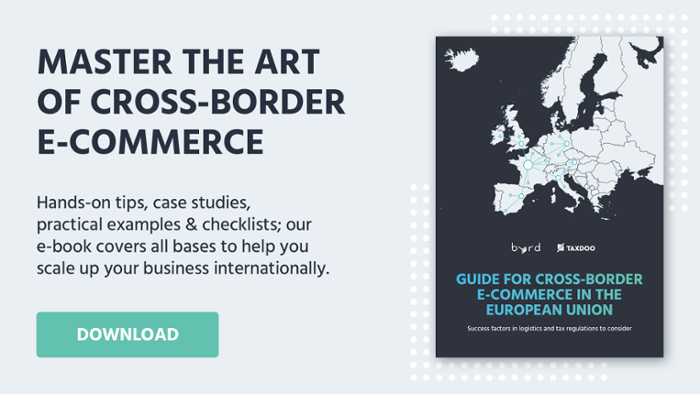Export Accompanying Document (EAD)
Table of Content
Imagine simplifying international trade while ensuring your goods transition smoothly across borders. The Export Accompanying Document (EAD) does just that. In this blog post, you’ll learn everything you need to know about the EAD, revealing its significance and guiding you on how to make the most of it.
An Export Accompanying Document, also known as an export declaration, serves as evidence of goods being exported abroad. It contains crucial details such as:
- Type, quantity, and value of the exported goods
- Destination
- Exporter
- Recipient
- Shipping route
- Mode of transportation
Why is the Export Declaration Necessary?
The EAD benefits customs in monitoring proper clearance and supervising exports. It also advantages the exporter by allowing them to track the type and use of the exported goods.
Moreover, it's often a prerequisite for receiving export subsidies or tax benefits. It can also be used as a trade document to facilitate business-to-business transactions, ensuring all required documents and paperwork are in order.
When Do You Need to Create an Export Accompanying Document?
There are various situations where an EAD must be created. For instance, it's an integral part of exporting goods from the European Union (EU) to third countries, like shipping from Germany to Switzerland. When exporting specific items, such as weapons, chemicals, or hazardous goods, an EAD is essential.
However, there are exceptions where an EAD isn't required. Some goods might be exempt from export restrictions or controls, or they might benefit from a specific free trade agreement that eases the export. For goods worth up to 1000 EUR and weighing up to 1000 KG, there's generally no need to produce an EAD.
It's advisable to familiarize yourself with the specific requirements for exporting goods in advance to ensure all required documents are correctly prepared.
How Much Does an Export Accompanying Document Cost?
Prices for an export declaration vary based on customs agents, the number of declarations, and the number of items. On average, charges range between 15 and 40 Euros per export shipment.
How Do I Create an Export Accompanying Document?
For several years now, the procedure is exclusively online and requires a direct interface with customs. Here’s a step-by-step guide to export declaration. Note that this might differ from country to country:
Step 1: Gather the required information
Before creating the EAD, gather all the necessary information related to the shipment. This includes details about the exporter, importer, goods being shipped, and any relevant supporting documentation. Ensure you have the following information at hand:
- Exporter's name, address, and contact details.
- Importer's name, address, and contact details.
- Description, quantity, and value of the goods.
- Harmonized System (HS) codes for the goods (used for customs classification).
- Country of origin of the goods.
- Invoice or commercial invoice.
- Transport details, including the mode of transportation, vessel/flight number, and expected arrival date.
Step 2: Determine the correct EAD type and specific requirements
The type of EAD you need to complete depends on the value and nature of the goods being exported. There are several types of EADs, including the Single Administrative Document (SAD) and the simplified procedure (if applicable). Consult with your local customs authority or shipping agent to determine the correct type of EAD for your shipment.
Step 3: Create the EAD
- Section 1:
Exporter's details: Fill in your name, address, and contact details as the exporter. - Section 2:
Consignee's details: Provide the importer's name, address, and contact details. - Section 3:
Goods description: Describe the goods being exported, including their quantity, value, HS codes, and country of origin. Specify any unique characteristics or additional details that customs may need to know. - Section 4:
Transport details: Enter the mode of transportation, vessel/flight number, and expected arrival date at the UK port of entry. - Section 5:
Declarations: Sign and date the document, certifying the accuracy of the information provided. - Section 6:
Supporting Documentation: Attach any necessary supporting documents, such as the commercial invoice or packing list.
Step 4: Review the document
Thoroughly review the Export Accompanying Document to ensure correctness and completeness. Confirm compliance with applicable regulations and attach all required documentation.
Step 5: Submit the Export Accompanying Document
Submit the EAD to the relevant authorities before the goods depart the country. Ensure all necessary documents are included.
Step 6: Track Shipment and Monitor Customs Clearance
After submitting the EAD, keep track of your shipment's progress and monitor the customs clearance process. Stay in touch with your shipping agent and customs authority to address any issues or provide any additional information that may be required.
Step 7: Receive Confirmation and Deliver Goods
Once the customs clearance process is complete, you will receive confirmation from the customs authority or your shipping agent. At this point, you can proceed with delivering the goods to the importer in the destination country.
It is important to note that the exact requirements and procedures for preparing an Export Accompanying Document may vary depending on the country and the type of goods. It is therefore advisable to find out about the specific requirements in advance and, if necessary, seek professional help to ensure that all documents are prepared correctly. For instance, the e-commerce fulfillment company byrd will be happy to provide support.
Conclusion
The Export Accompanying Document (EAD) is an indispensable tool for merchants looking to export goods. It serves as proof of export and is demanded by customs authorities. The EAD enables exporters to trace their goods and benefit from export subsidies or tax incentives.
It's vital to consider the specific requirements for exports and, if necessary, seek professional help to ensure correct document preparation.
If you have questions or need support in e-commerce fulfillment, we're always here to help.
